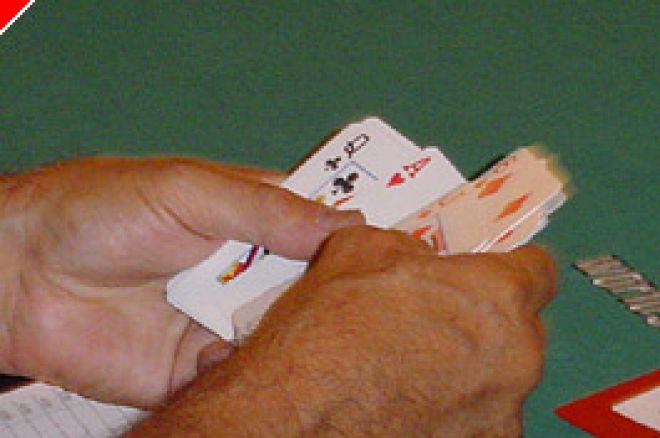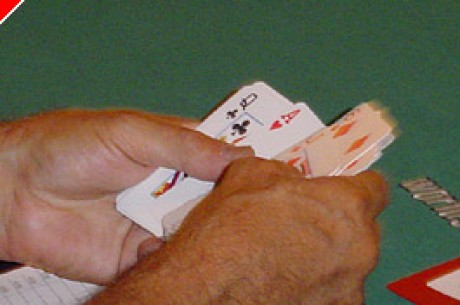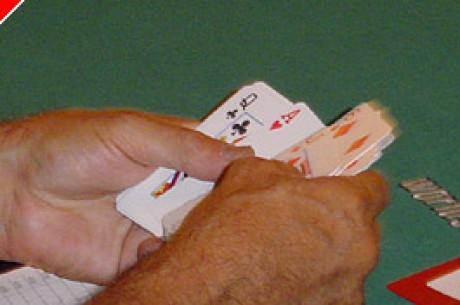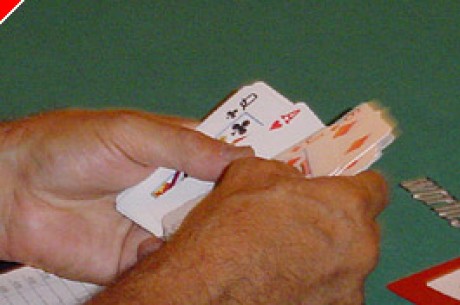Stud Poker Strategy - Chasing, Part One

When I was first starting to learn about how to play poker, I learned the importance of playing what was referred to as tight/aggressive poker. In a nutshell this meant betting when you had the goods and folding when you didn't. It was considered a mistake to chase - that is to play from behind, hoping to catch up to someone who was betting and in the lead with a better hand. It was, in fact, the sign of a weak player - someone who didn't have the self control or discipline to get away from their weaker hand. "Calling stations" we called them.
In truth, however, chasing, is profitable in certain circumstances. It is true for all levels of stud - and especially so as the antes and bring-in represent an increasingly larger percentage of the bet.
Let's first look at a low stakes game. You'll see quickly, I'm sure, why chasing makes sense.
You are playing $1-5 Stud with a $.50 ante and a $1.00 bring in. You have the bring in of $1.00. Your hand is (3h4h)5h. You have a 5 high, a 3-Flush and a 3-Straight. This being a typical low limit game, you get five callers. Your cards are completely live - no hearts and no 2s, 3s, 4s, 5s or 6s are out.
On Fourth Street you get, by golly, the 6h. You have four to a straight flush. Of course you have no hand at all right now, but you have many, many ways to improve - 9 hearts will give you a flush; six additional cards will give you a straight, and two of the flush cards will actually give you a straight flush. You have a 15 outer with three cards to come - about 75% of the time you'll hit at least a Straight. Surely it makes sense to chase even if you think you're chasing a pair of Aces.
Here's another example where chasing makes sense. Imagine it's Sixth Street. There have been four players in until then in this loose passive game. You have two low pair - 6s and 3s. They are completely live. You're against a hand that you are sure is Aces Up and against another hand that you are pretty sure is a Flush. They keep raising each other. You have no idea what the other player has but he's calling along. He could have any kind of draw - maybe he's going for a Flush.
You are tempted to fold. Your two pair is not likely to become a full house. Even so, the pot is enormous - with at least 20 large bets. Should you call the last raise on 6th Street that convinces you that your opponent does indeed have a flush and his opponent definitely has Aces Up?
The answer is certainly to chase - even though you're woefully behind. You have 4 outs - that makes you a 12.5:1 underdog. But if you do hit, you're almost certain to win an enormous pot. It will be at least 25 times the size of your large bet - plus there is almost certainly going to be at least another large bet and probably one or two more large bets that you'll win when you bet the River. So you surely chase.
It is certainly easier in the lower stakes games to play a rigid game, where you only enter a pot when you have a Premium Pair or Trips, you bet aggressively when you are convinced you're in the lead and you fold to any pressure if you think you've fallen behind. But though this may be simple, it is not correct. You must understand when it is profitable for you to call as an underdog. Straight draws, Flush draws, Full-House draws all make sense if the pot is offering you a good enough price for your call. If you quit just because you are behind you are giving up an enormous amount of potential profit. You must call from behind much of the time if you are to be an overall winner at stud - even at the lowest stakes tables.
Ed note: Party Poker have stud available at every limit, 24 hours a day.








